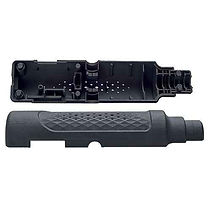
HP Multi Jet Fusion
HP Multi Jet Fusion 3D Printing Services
Volume production of end-use parts
Here at Tempus 3D we use HP's Multi Jet Fusion 5200 3D printer because of it's industry-leading capabilities that make it one of the most popular choices in the industrial sector for rapid prototyping and low-to-mid volume manufacturing of end-use parts.
This equipment is designed specifically for the production environment to mass-produce engineering-grade plastic parts with excellent mechanical properties at a low cost per part. With printing speeds up to 10x faster than comparable technologies, Multi Jet Fusion is a popular choice for the transition between prototyping and mass production of end-use parts.
This technology is also an economical alternative to injection molding with more design freedom, shorter lead times and greater adaptability.

Tempus 3D is proud to be a qualified member of
HP's Digital Manufacturing Network
As an HP Digital Manufacturing Network Production Professional, Tempus 3D has been evaluated and qualified based on our end-to-end 3D printing capabilities for production at scale, as well as our manufacturing and quality processes.
Applications for Multi Jet Fusion

MJF is ideal for building prototypes that can be tested in real-world applications for form, fit and function.
Functional prototyping

Multi Jet Fusion is up to 10x faster than it's competition, making it an affordable alternative to injection molding.
Manufacturing

MJF is a popular choice for industries where customization is important, such as medical and consumer goods.
Mass customization

HP Multi Jet Fusion Materials

HP Nylon PA12
Strong, detailed, low-cost quality parts suitable for a wide range of applications. Chemical resistance and biocompatible. HP's most popular 3D printing material.
_ed.jpg)
Ultrasint TPU
TPU (Thermoplastic Polyurethane) is a rubber-like polymer ideal for producing parts that require high elasticity, shock absorption, elasticity and energy return.

Nylon PA12 GB
HP Nylon 12 filled with 40% glass bead to give stiffness and stability while maintaining the excellent material qualities of HP Nylon PA12. Ideal for stiff, functional parts.

Polypropylene
This durable plastic has high elasticity, low moisture absorbtion, and high elongation at break. It is an excellent choice for light, water-tight, and durable parts.

How does Multi Jet Fusion work?

Multi Jet Fusion (MJF) is a Powder Bed Fusion technology designed by HP for manufacturing end-use plastic parts. A thin layer of powder (0.08 mm thick) is laid in the build platform and fusing and detailing agent is laid on top. Each layer is fused ~10 layers deep with irradiant heat. With this process hundreds of parts can be built at once, compared to one at a time with most 3D printing technology such as SLS or FDM.
This unique printing process produces parts with high density and low porosity, with excellent mechanical properties and an exceptionally smooth surface straight out of the printer. This process also means short lead times, ideal for rapid prototyping and small- to medium-production runs of engineering-grade end-use parts.
Additional post-production treatment can enhance the surface finish and performance of the parts.